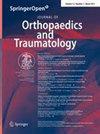自体结构骨移植重建初级全膝关节置换术中深度≥ 10 毫米的胫骨内侧近端未闭合缺损
IF 3.7
2区 医学
Q1 ORTHOPEDICS
引用次数: 0
摘要
在初级全膝关节置换术(TKA)中,处理胫骨内侧近端未愈合的缺损具有挑战性,尤其是深度≥ 10 毫米的缺损。本研究旨在评估自体结构骨移植治疗这些缺损的效果。在这项前瞻性研究中,对胫骨内侧近端深度≥10毫米的非封闭性缺损患者进行了TKA手术,采用自体结构性植骨并用螺钉固定,随访至少36个月。通过膝关节社会评分(KSS)和西安大略和麦克马斯特大学骨关节炎指数(WOMAC)对患者进行临床随访。此外,还进行了放射学随访,以评估植骨结合和植入物的稳定性。研究共纳入48名患者,平均年龄为(69.2 ± 4.5)岁。平均体重指数(BMI)为 31.4 ± 3.7 kg/m2。平均缺损深度为 17 ± 3.6 毫米。平均随访时间为(52.2 ± 12.3)个月,KSS中位数从术前的30分显著提高到89分,P < 0.001。WOMAC评分中位数从术前的85分明显降低到30.5分,P < 0.001。平均活动度从术前的 73 ± 12.4 度明显增加到 124 ± 8.4 度,P < 0.001。平均移植物结合时间为 4.9 ± 1 个月。无重大并发症报告。自体骨移植重建是一种安全有效的方法,可解决初次 TKA 中胫骨近端内侧缺损的问题。四级。本文章由计算机程序翻译,如有差异,请以英文原文为准。
Autogenous structural bone graft reconstruction of ≥ 10-mm-deep uncontained medial proximal tibial defects in primary total knee arthroplasty
Management of uncontained medial proximal tibial defects during primary total knee arthroplasty (TKA) can be challenging, especially for defects ≥ 10 mm in depth. This study sought to assess the outcomes of autogenous structural bone grafts to address these defects. In this prospective study, patients with uncontained medial proximal tibial defects ≥ 10 mm in depth undergoing TKA were managed by autogenous structural bone grafts fixed by screws and were followed up for at least 36 months. Patients were followed-up clinically with Knee Society Score (KSS) and Western Ontario and McMaster Universities Osteoarthritis Index (WOMAC). Additionally, radiological follow-up was done to assess bone graft union and implant stability. The study included 48 patients with a mean age of 69.2 ± 4.5 years. The mean body mass index (BMI) was 31.4 ± 3.7 kg/m2. The mean defect depth was 17 ± 3.6 mm. With a mean follow-up period of 52.2 ± 12.3 months, the median KSS improved significantly from 30 preoperatively to 89, P < 0.001. The median WOMAC score reduced significantly from 85 preoperatively to 30.5, P < 0.001. The mean ROM increased significantly from 73 ± 12.4 preoperatively to 124 ± 8.4 degrees, P < 0.001. The mean graft union time was 4.9 ± 1 months. No significant complications were reported. Autogenous bone graft reconstruction is a safe and effective method of addressing uncontained medial proximal tibial defects in primary TKA. Level IV.
求助全文
通过发布文献求助,成功后即可免费获取论文全文。
去求助
来源期刊

Journal of Orthopaedics and Traumatology
Medicine-Orthopedics and Sports Medicine
CiteScore
4.30
自引率
0.00%
发文量
56
审稿时长
13 weeks
期刊介绍:
The Journal of Orthopaedics and Traumatology, the official open access peer-reviewed journal of the Italian Society of Orthopaedics and Traumatology, publishes original papers reporting basic or clinical research in the field of orthopaedic and traumatologic surgery, as well as systematic reviews, brief communications, case reports and letters to the Editor. Narrative instructional reviews and commentaries to original articles may be commissioned by Editors from eminent colleagues. The Journal of Orthopaedics and Traumatology aims to be an international forum for the communication and exchange of ideas concerning the various aspects of orthopaedics and musculoskeletal trauma.
 求助内容:
求助内容: 应助结果提醒方式:
应助结果提醒方式:


